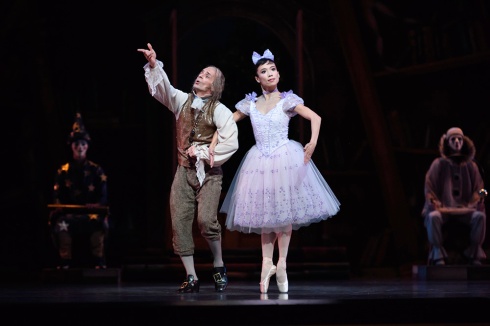March 16 San Francisco Ballet presented just two ballets with highly opposite treatments: Jerome Robbins’ 1969 Dances at a Gathering to Chopin’s music played by Roy Bogas and the 2015 Yuri Possokhov work called Swimmer with a composite score by Shinji Eshima, Kathleen Brannan, Gavin Bryars, and Tom Waits. Hard to conjure more divergent use of the classical canon. The divergence in taste was testified to by a distinct winnowing of the audience following Dances at a Gathering.
Dances at a Gathering was premiered at New York City Ballet 47 years ago. I dare say it is for the American ballet world what Les Sylphides was for Russian Ballet in the early 20th century. Staged again by Jean-Pierre Frohlich with Jenifer Ringer Fayette with Jennifer Tipton’s sensitive lighting, it demonstrates just how aware Robbins could be in his creative insights forty six years ago. The dancers waft on and off with remarkable naturalism, starting with Joseph Walsh touching the earth, the space where the emotions would follow, lightly but indelibly sketched. Lorena Feijoo was given the difficult task of a feminine initiator, rebuffed several times, but taking the rejections with hands moving from the wrist, “ Tout va change, tout va reste le meme chose.”
I was particularly caught by Carlo Di Lanno’s dancing. When he raises his arms en haut, he does it with a breath, the inhalation providing a distinct lightness to the movement. When the group of three man were dancing on a slight diagonal line opposite three women, his port de bras perfectly echoed the line of his extended right leg, a moving diagram in dance.

Vanessa Zahorian and Carlo DiLanno in Robbins’ Dances at a Gathering. (© Erik Tomasson)
Supported by Ray Bogas at the piano, Dances at a Gathering spun its mid-summer late afternoon magic, leaving us intensely gratified and wanting to see it again soon.
Swimmer enjoys Alexander V. Nichol’s superb visuals with Taras Domitro waking, executing perfunctory exercises, of course exaggerated, showering with projections expanding the splashes – outlandish in our drought conscious society – before sitting down to breakfast with the papers –which were flashed large and varied as Domitro sits in front of cardboard wife and children before having another cardboard wife deliver him his jacket. Kate Duhamel’s video designs accent the vignettes throughout, water being one of the principal themes, from the shower to the ocean. I felt the water image in its various forms was somewhat overdone, a “get my point, see what I mean” emphasis. Domitro was marvelous throughout, lean, agile and airborne.
Next follows “the commute,” featuring fellow passengers, another visual bus, strap-hangers, bus chugging along, going up hills and a thoroughly exaggerated 190 degrees, a wonderful tunnel, before portraying “the office,” equally exaggerated. Projections of computers and reams of paper being spewed out flash across the screen, walked across for checking with a woman signing the stack furiously. No doubt about it, as a retired office worker myself, Possokhov has an unerring comic touch.
Up to that point Possokhov is dead on. Then he has his “hero” encounter mass media, Hollywood, Pool Party and a First Swim, followed by specific literary references; they unfold, conveying the essence of subject matter as seen from a foreign-born, foreign resident’s eye. Apart from content, and unlike prior Possokhov productions, the stage settings begin to blur choreographic patterns and dancers. If that was the intent it certainly succeeded, but it marred some glimpses of excellence, particularly of Gennadi Nedvigin and Pascal Molat whose company performing days dwindle down precipitously, an overly advanced September.
Tiit Helimets and Maria Kochetkova enacted Lolita with the seduction gradually changing from man to nymphet to nymphet to man, followed by Lorena Feijoo and Vitor Luiz on stairs. Carolyn Carvajal observed that both pas de deux were danced to songs rendered with Tom Wait’s gravelly voice; a neat observation between voice and the physical encounter, regardless of motivation.
Swimmer has an ability to convey a certain quality in contemporary American life, a shallowness all too prevalent, images piled one after another to make one cringe at its unerring display of distractions, of sensation minus feeling. The contrast with Robbins’ work was telling.

